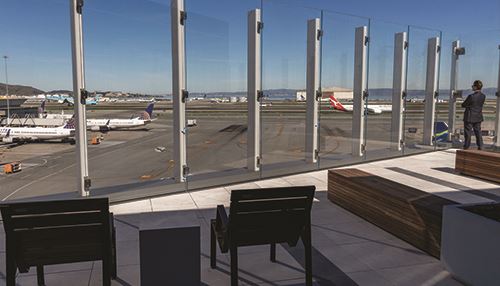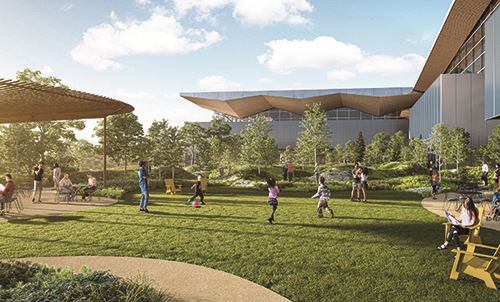When Pittsburgh International Airport (PIT) unveiled the details of its $1.4 billion Terminal Modernization Program a few years ago, one feature marked a striking design departure for the airport. Plans included four expansive open-air terraces teeming with greenery and easy access to nearby indoor concessions.
 “This is a novel, unique move for PIT, and a rarity for most U.S. airports,” says Chief Development Officer Paul Hoback. “There are no other significant, deliberate outdoor spaces at PIT, which is why the new outdoor terraces are essential to our modernization vision.”
“This is a novel, unique move for PIT, and a rarity for most U.S. airports,” says Chief Development Officer Paul Hoback. “There are no other significant, deliberate outdoor spaces at PIT, which is why the new outdoor terraces are essential to our modernization vision.”
Together, the four open-air areas, will offer passengers 90,000 square feet of outdoor space above and beyond the 700,000 square feet of other terminal renovations. Cost for the new outdoor areas is estimated at $7 million. Two terraces will be located before the TSA checkpoints, and two after. Guests will access the landside terraces from PIT’s new public meter/greeter area on the second-floor arrivals level. Ticketed passengers will access the post-security terraces from the main concourse level of the new terminal, to the west of the existing central core.
|
facts&figures
Location: Long Beach (CA) Airport 2019 Passenger Volume: 3.6 million Size of Outdoor Garden Area: 20,000 sq. ft. Cost: Approximately $2 million Prime Contractor for Phase 1 Terminal Improvement Project: Edge Development Main Architect for Phase 1 Terminal Improvement Project: HOK Concessions Area Design: Studio One Eleven Garden Concessions: All local to Long Beach & operated by Paradies Lagardère Concessions Lineup: 4th Street Vine Wine & Beer Bar; Boathouse on the Bay; George’s Greek Café; Long Beach Burger Bar; Sheldrake Coffee Roasting; Sweet Jill’s Bakery; Taco Beach Cantina Outdoor Furniture: Vestre Garden Debut: 2012
Location: Missoula (MT) Int’l Airport 2019 Passenger Volume: 900,000 Existing Deck: 1,200 sq. ft. Seating Capacity: 40-50 people Pending Deck: 1,500 sq. ft. Seating Capacity: 40-50 people Timeline: 1st deck opened in 2014; 2nd is slated to open later this year Cost: $415,000 for existing deck; $300,000 for new deck Architect: A&E Design Prime Contractor: Martel Construction Engineering: Morrison Maierle
Location: Pittsburgh Int’l Airport 2019 Passenger Volume: 10 million Project Scope: 4 open-air terraces (2 landside, 2 airside) Total Space: 90,000 sq. ft. Cost: About $7 million (contract not awarded as of early Feb.) Component of: Terminal Modernization Program Design Leads for Terminal Modernization: Gensler+HDR in association with luis vidal + architects Construction Management: PJ Dick/Hunt and Turner Structural Steel, Concrete/Foundations, Architectural Enclosure: Mascaro Exterior Enclosure: D-M Products Timeline: Contracts for landscaping & site finishes for outdoor terraces expected to be awarded later this year; newly renovated terminal slated to open in 2025
Location: San Francisco Int’l 2019 Passenger Volume: 57.6 million Deck Size: 1,460 sq. ft. Cost: $6.3 million Designer: Woods Bagot/AE3 Joint Venture Opened: Feb. 2020 Bird-Deterring Glass: GlassPro Glazing: Capitol Glass Seating Vendor: Landscape Forms Security Contractor: Covenant Aviation Security Noteworthy Feature: Exhibit about history & architecture of 1954 terminal facility that previously occupied space where deck is now located Deck Traffic: Nearly 3,000 guests visited during its grand opening weekend; current volume is 100-200 visitors/week |
“The ultimate goal is to provide an amenity to airport guests, particularly past security, to reduce the anxiety that often accompanies air travel,” Hoback explains, adding that access to fresh outdoor air will boost well-being for passengers and employees alike.
The new outdoor areas will be landscaped with regional trees and vegetation, a design theme foreshadowed with tree and rock arrangements near the new terminal entrances. “[It] represents the surrounding landscape of the western Pennsylvania region, introducing guests to the beauty of the area,” says Hoback.
The outdoor terraces and other terminal renovations are slated to debut in 2025.
On Deck
Given the perennial appeal of watching aircraft land and take off, there is a long history of observation decks at airports. John F. Kennedy International, Hartsfield-Jackson Atlanta International and Tennessee’s Tri-Cities Airport are just a few that have offered such spaces for years.
The $415,000 outdoor deck Missoula International (MSO) opened in 2014 proved to be such a hit that the Montana airport is in the midst of adding another one. “People come to [this area] to be outdoors, so it has been very well received,” explains MSO Director Brian Ellestad.
The airport’s existing 1,200-square-foot deck, located near Gate 3, includes a bar, moveable outdoor furniture, and low glass walls that provide expansive views of the airfield and mountains beyond.
Ellestad explains that anticipated passenger growth and an associated need for more holdroom space inspired him to initiate the project, and the timing ultimately proved to be spot on. Passenger volume at MSO grew 53% between 2013, when the deck project began, and 2019, when the airport served a record 900,000 passengers.
With more growth projected, the airport included a second, $300,000 outdoor deck in its $72 million terminal project that is expected to wrap up later this year. The new 1,500-square-foot deck will feature full-service food and beverage concessions, an outdoor fireplace and outdoor seating.
Tim Damrow, deputy director at MSO, notes that the new amenity will provide passengers with fresh air and great views while they wait to depart. Moreover, he describes the project as a great low-cost investment that adds needed space during the peak summer travel but can be decommissioned in winter.
A&E Design, which worked on both deck projects, located the new outdoor deck in a central area on the second floor to take advantage of the terminal’s southern exposure and 180-degree view down the Bitteroot Valley.

“I think people are genuinely fascinated by the idea of flight, and placing a human in that space to experience airside activities is truly unique,” says Chris Martison, an A&E Design principal.
San Francisco International Airport (SFO) added an observation deck in early 2020 for similar reasons. Located atop Terminal 2, the SkyTerrace features 180-degree views of SFO’s airfield, including the busy area where all four runways intersect.
“For many of us, coming to SFO with family to watch airplanes helped inspire our love for aviation,” says Airport Director Ivar C. Satero. “With the SkyTerrace, we hope to bring that same passion and excitement to new generations of families.”
The 1,460-square-foot deck is enclosed with vertical glass for wind protection, but is open above to maximize views of planes and the sky. The glass panels, which also provide views of San Francisco Bay, have subtly-shaded vertical stripes. Doug Yakel, public information officer for SFO, explains that the striping is nearly invisible from inside the deck, but birds outside see it clearly and consequently don’t fly into the area.
Airport officials opted to locate the $6.3 million deck pre-security to make the amenity available to the general public. The area is open from 10 a.m. to 6:00 p.m. Fridays through Mondays, and non-ticketed visitors must undergo security screening to enter. Masks are required in the space, with airport and security staff enforcing the policy.

“Visitors are welcome to bring food and beverages into the area, and we are looking at adding concessions to the space in the future,” adds Yakel.
Traffic on the deck has fluctuated due to COVID-19. More than 1,900 airport guests and 950 employees visited the new outdoor space the first weekend it opened in February 2020. After a brief pandemic-related closure, it re-opened in summer 2021 and currently draws 100 to 200 visitors each week.
Garden Oasis
One determinant of whether a given airport space is successful is its staying power. At Long Beach Airport (LGB), a post-security outdoor garden area remains popular and busy a full decade after it opened.
While use of the space has evolved over time, an enduring part of its appeal is the ample Southern California sunshine. The area also features bars and multiple eateries, glass doors that open to the outside, movable furniture, a fireplace as well as live music from local musicians. The live performances stopped during the early phase of the pandemic, and then resumed in summer 2021.
Airport Director Cynthia Guidry reports that the outdoor garden area has consistently received praise from travelers ever since it opened in 2012. The area was developed for about $2 million during Phase One of LGB’s Terminal Area Improvement Program.
 “Square footage limitations on our facilities…helped spark the idea to incorporate more outdoor space,” Guidry notes. But the feature also reflects LGB’s history as a largely outdoor airport, with passengers boarding and deplaning on the tarmac instead of through enclosed jet bridges and outdoor baggage claim facilities.
“Square footage limitations on our facilities…helped spark the idea to incorporate more outdoor space,” Guidry notes. But the feature also reflects LGB’s history as a largely outdoor airport, with passengers boarding and deplaning on the tarmac instead of through enclosed jet bridges and outdoor baggage claim facilities.
Guidry describes the garden area as a boutique, resort-like setting that is quintessentially Southern Californian. “It fits perfectly into our brand for an easygoing, stress-free experience,” she remarks.
Social Distancing
Outdoor spaces, even those planned or built before COVID-19, have become valuable assets in the current era of social distancing. Take the features at PIT and LGB, for example.
Officials are certainly appreciating benefits not initially envisioned for the garden terraces at PIT. As Hoback explains, “While the concept was not developed as a response to the pandemic, what better time to provide such an amenity—when guests desire fresh air options and opportunities to distance themselves from areas typically more densely populated?”
A series of post-pandemic design workshops in summer 2020 affirmed PIT’s vision for the terminal modernization in 2017 for outdoor terraces, he adds.

The relatively recent need for social distancing has also reinforced the popularity of the outdoor garden area at LGB. As Guidry puts it, “Our travelers have voted with their feet. With the onset of the pandemic, we began to see a much stronger demand for use of the space—not just as a place to pass through and take photos, but as one of the main holding areas for our gates.”
The airport consequently added more seating, furniture and dining tables to accommodate the increased volume. “Whatever seating options we have made available have immediately been put to good use,” Guidry reports. “Some of this is simply a desire to enjoy the sunshine. But I also believe the desire to socially distance and to stay outside without needing to wear a mask is a strong motivating factor.”

Alfresco Concessions
On another front, outdoor spaces offer airports enticing opportunities to increase revenue by supplementing or elevating their food and beverage lineups. LGB’s garden area, for instance, is flanked on two sides by a variety of concessionaires, and all are local. Options include a full-service bar, a restaurant with table service, and counter service for items such as bakery goods, tacos, burgers and freshly roasted coffee. As Guidry puts it: Seven local companies provide food and beverages, while the garden itself provides a peaceful atmosphere and “unique Instagram-worthy setting” for guests.
 Concessions are a key component to the outdoor area at LGB. Michael Bohn, senior principal of architecture firm Studio One Eleven, explains that the solid walls of two concourse buildings that fronted the area were replaced with glass doors that enable the wine bar and restaurant to connect to the outdoor space. Regional landscaping and new outdoor furnishings created an upgraded space for dining and drinking while passengers wait to board.
Concessions are a key component to the outdoor area at LGB. Michael Bohn, senior principal of architecture firm Studio One Eleven, explains that the solid walls of two concourse buildings that fronted the area were replaced with glass doors that enable the wine bar and restaurant to connect to the outdoor space. Regional landscaping and new outdoor furnishings created an upgraded space for dining and drinking while passengers wait to board.
At MSO, previous experience is pointing the way forward regarding concessions. Currently, the airport’s vendor delivers food and beverages to the existing deck near Gate 3. The new deck, however, will be located right next to the vendor’s existing restaurant/bar for greater ease. Moreover, it will be front and center as passengers enter the secure area. “We have also designed an outdoor fireplace and are working on ways to make it function year-round,” adds Ellestad.
The concessions program for PIT’s outdoor terraces is in the final planning stages. As of late January, spaces were designated near terrace access points to allow food and beverages to be purchased and consumed outdoors, but specific brands had not been selected. Hoback notes that the lineup is being crafted to suit local guests. “PIT has a particularly high percentage of meeters and greeters who enjoy picking up and dropping off loved ones, waiting for them and seeing them off inside the terminal,” he explains, “Our goals for a modernized concessions program will accommodate that unique occurrence here.”

What Works
Implementing open-air spaces with commercial, functional and aesthetic appeal is no walk in the park.
 To help make it happen, MSO’s Ellestad suggests establishing agreements with tenants and vendors about operating and maintaining such areas. “Keep security requirements in mind during the design phase, and also the potential of introducing debris onto the airfield, from smoking, plants and concessions items,” he advises. “It’s important to have a plan to mitigate these issues.”
To help make it happen, MSO’s Ellestad suggests establishing agreements with tenants and vendors about operating and maintaining such areas. “Keep security requirements in mind during the design phase, and also the potential of introducing debris onto the airfield, from smoking, plants and concessions items,” he advises. “It’s important to have a plan to mitigate these issues.”
Martison, who helped design MSO’s new deck, reminds other airports interested in similar spaces to consider the proximity of nearby aircraft and whether they will be pushed from gates or will power out. Operating noise and fuel odors could be problematic and should be considered with these types of spaces, he notes.
Focusing more on conceptual issues, PIT’s Hoback recommends creating an engaged, collaborative team that understands the importance of building a space that accurately reflects the region.
Finally, it is worth bearing in mind that an effective outdoor area can cut to the very core of an airport’s identity. Guidry notes that the garden area at LGB is a prized amenity for travelers. “But it’s about more than just setting aside the space and putting furniture out,” she emphasizes. “This is an opportunity to build upon your existing aesthetic and to deepen the sense of place.”
For some airports, that place can, indeed, be outdoors.
|
Other Outdoor Standouts For more information about the native landscaping program at Phoenix Sky Harbor International, check out the November/December 2019 of Airport Improvement magazine. For details about an exterior walkway project at El Paso International, consult our July/August 2019 issue. |


 Project: Garden/Outdoor Concessions Area
Project: Garden/Outdoor Concessions Area




